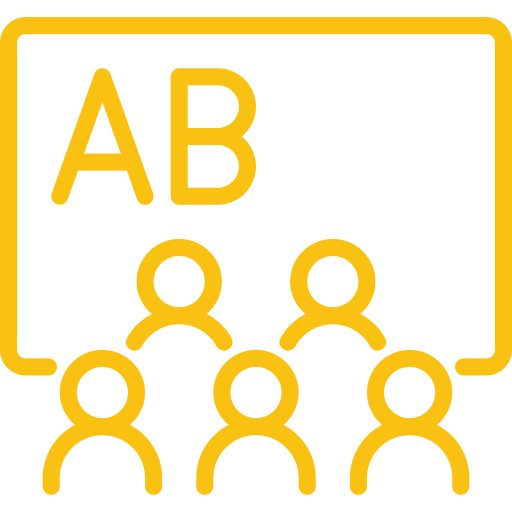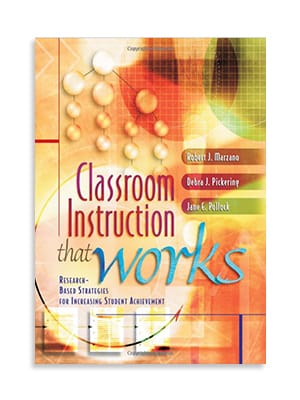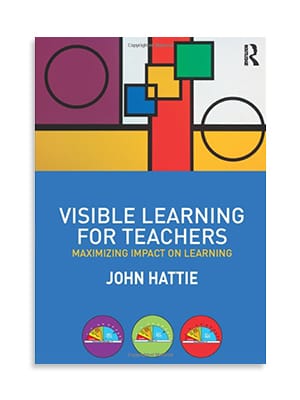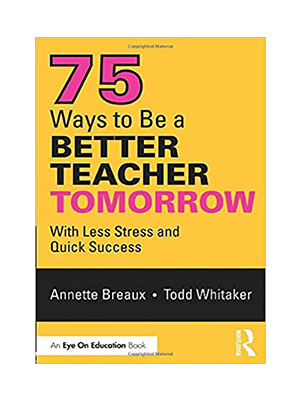Why is new teacher orientation so important?
The first few days will set the tone for the new school community. Think back to your own new teacher orientation, and try to remember what you talked about.
Unless you are a first year teacher, you probably are drawing a blank.
So consider that as you go through this list, and remember to keep things a little light.
#1 First impressions matter
A great way to start the first day is to personally greet each new teacher, showing them genuine enthusiasm for joining your family. If you seem too busy to talk to them for the first time you are together, it leaves the impression that you’ll never truly have an “open door.”
It’s the wrong time to try to be something you aren’t though. The meeting should reflect how you want the relationship to be with your staff, if you don’t share personal information then don’t force it. It might be too much in a large group, or it could be perfect for smaller groups.
And don’t forget food. Hungry people are thinking about what they want to eat, not what you are talking about. Whenever possible, bring in local food to give them an idea of what the area has to offer (unless the food isn’t good in your area, then maybe skip that part).
#2 School culture and expectations
It’s essential to provide an in-depth understanding of your school’s culture, values, and expectations. It’s one thing to share facts and make statements, but one of the best ways to show your people who you really are is to share stories and examples that highlight the core values that your district stands for.
They’re easier to remember, and they stick with people longer than a mission statement. Don’t believe me? Ask a few coworkers what your school’s mission statement is, and you’ll get some vague ideas, some generalizations. But people remember stories.
To foster a sense of ownership, I would involve new teachers in discussions about the school’s values and expectations, allowing them to reflect on how they align with their own teaching philosophy. By creating space for dialogue and reflection, new teachers can internalize the values and feel a sense of ownership in upholding them.
Too often new teacher voices are shut down, making fitting in with the larger group something they have to do, rather than making it a two way street.
It’s hard to feel like you belong when all you see is a list of things you have to do, without allowing any freedom to come up with their own lesson plans or combine on a great activity.
#3 School policies and procedures
In the new teacher orientation, it is crucial to familiarize the new teachers with the school’s policies and procedures to ensure a smooth transition into their roles. It’s important to provide a comprehensive overview of the essential policies and procedures that guide the day-to-day operations of the school, as well as some of the big picture policies.
I would start by explaining attendance policies, including protocols for reporting absences, requesting leave, and documenting student attendance. Clear guidelines on punctuality, tardiness, and procedures for managing late students would be provided to ensure a consistent and efficient start to each school day. I’m a veteran teacher, and even I sometimes get caught up in starting class and forget to take attendance. It happens. Here’s how to fix it.
Grading policies and procedures would also be thoroughly explained, covering aspects such as grading scales, grade book systems, due dates, and the process for calculating and submitting final grades.
This clarity would help new teachers align their grading practices with the school’s expectations and maintain consistency across subject areas. Don’t spend too much time on it, this will need to be revisited later.
To ensure a safe learning environment, I would review the school’s safety protocols and emergency procedures. This would include fire drills, lockdown drills, severe weather procedures, and evacuation plans. New teachers would be made aware of their responsibilities in emergencies and the steps to follow to ensure the safety of themselves and their students.
Additionally, I would introduce new teachers to administrative systems and technology tools used in the school. This would include guidance on accessing student information systems, digital platforms for lesson planning (if you use them) and communication, and any other technology resources relevant to their teaching responsibilities.
Training sessions or workshops may be scheduled to provide hands-on experience and support in utilizing these tools effectively, again at a later date if needed.
#4 Curriculum and instruction
I would begin by providing an overview of the curriculum frameworks and standards that serve as the foundation for teaching and learning in the school. This would include an explanation of the scope and sequence of each subject area, the key learning objectives, and the expected student outcomes.
Depending on the size of your district, this is something that should probably be a bigger part of the mentoring program.
To support new teachers in their lesson planning, I would offer guidance on effective instructional strategies and pedagogical approaches. Don’t assume they know.
This may include discussions on differentiated instruction, project-based learning, cooperative learning, and other research-based instructional methods. Sharing examples of successful instructional practices from experienced teachers in the school would also be valuable in illustrating effective teaching strategies.
To foster ongoing professional growth, I would highlight the importance of assessment and feedback in the instructional process. Providing guidance on various assessment techniques, such as formative and summative assessments, would enable new teachers to gauge student progress and adjust their teaching accordingly.
I would also emphasize the significance of using assessment data to inform instructional decisions and support student growth.
As much as I hate to talk about data, it is part of best practices now and is a big driver of classroom instruction.
#5 Classroom management
The basics to discuss include the key principles of effective classroom management, such as establishing clear expectations, routines, and procedures. New teachers would be encouraged to develop their classroom rules and procedures that align with the school’s broader expectations, ensuring consistency across classrooms.
They may need help here, as many new teachers just assume that their students will all behave, especially if their new role brings them to a district with a more challenging population.
To support new teachers in creating a positive classroom climate, I would provide guidance on building relationships with students based on mutual respect and trust. Strategies for creating a welcoming and inclusive environment, promoting student participation, and addressing diverse learning needs would be shared. This would include techniques for effective communication, active listening, and conflict resolution.
Additionally, I would introduce new teachers to strategies for managing student behavior in a proactive and positive manner. This would include techniques for setting and reinforcing expectations, implementing behavior management systems, and addressing challenging behaviors. I would emphasize the importance of maintaining a balance between firmness and fairness while considering individual student needs and circumstances.
#6 Support services
This is a big part of the school system, but one that you shouldn’t spend too much time on. They’ll have a lot on their plate, so some quick introductions and/or a sheet explaining things can be sufficient.
That being said…
I would introduce new teachers to the special education services offered in the school, including the processes for identifying and supporting students with individualized education plans (IEPs) or 504 plans.
I would explain the roles and responsibilities of special education teachers, the procedures for collaborating with them, and strategies for fostering an inclusive learning environment for students with special needs.
Furthermore, I would provide information about English language learner (ELL) programs and resources available to support students who are learning English as a second language. New teachers would be informed about the strategies and instructional approaches that are effective in supporting ELL students’ language development and academic progress.
To address the social and emotional needs of students, I would introduce new teachers to counseling services and the role of school counselors.
It’s crucial for new teachers to understand how to refer students to counseling services when necessary and how to collaborate with counselors to support students’ well-being and academic success.
#7 Building relationships
This is really the one thing that can make or break teachers of all grade levels.
I’d begin by emphasizing the importance of building positive relationships with students as a foundation for effective teaching and learning. New teachers would be encouraged to create a classroom culture that values respect, empathy, and open communication.
Strategies for fostering positive student-teacher relationships, such as getting to know students individually, actively listening to their needs and concerns, and providing timely feedback, would be shared.
Collaboration with colleagues is also crucial in the teaching profession. I would stress the value of working together, sharing ideas, and seeking support from experienced teachers and staff members.
New teachers would be encouraged to actively engage in collaborative opportunities, such as team meetings, professional learning communities, and interdisciplinary projects. By fostering a culture of collaboration, new teachers can benefit from the collective wisdom and expertise of their colleagues.
Involving parents/guardians in the educational process is another essential aspect of building relationships. I would provide strategies for effective communication with parents/guardians, such as regular newsletters, parent-teacher conferences, and open-door policies.
New teachers would be encouraged to establish a partnership with parents/guardians, involving them in their child’s education and addressing any concerns or questions they may have.
In addition, I would emphasize the importance of cultural sensitivity and awareness in building relationships. New teachers would be encouraged to respect and value the diverse backgrounds and experiences of students and their families.
Providing resources and professional development opportunities to enhance cultural competence would be beneficial in creating an inclusive and welcoming environment for all.
#8 Evaluation and feedback
At some point, this has to come up. You have to explain the evaluation process used in the school, including the criteria and standards upon which teachers are assessed. New teachers would be provided with a clear understanding of the evaluation timeline, procedures, and the expectations for their performance.
This transparency would help alleviate any uncertainties and set the stage for a fair and constructive evaluation process. What you are truly looking for is to get rid of the fear of the unknown for new teachers.
#9 Create an online resource library for teachers
Even if you develop the best new teacher orientation in the history of education, my guess is pretty much every teacher will still have questions. Even about the things you covered. It’s just too much to retain, everything listed above.
That’s why I recommend creating an online resource library. This is actually something that can benefit the entire staff.
As a building principal (or any of the other school administrators), you’ll forget who has been there for every meeting you’ve had. Between sick days, vacations, their kid’s sick days, we all know that it’s pretty rare to have everyone in attendance.
It’s even more rare to have everyone in attendance’s attention for an entire meeting.
By providing an online resource area, you can give your teachers a link to your web page that answers most of the questions that pop up throughout the year.
Not only does this set clear expectations on what you want them to know and do, there’s also a good chance that your school leaders will receive fewer questions from the entire school staff. Communication is extremely important, and it will save a great deal of time for both sides.
Plus, as new questions and ideas pop up, you simply add them to the library.
This means that you’ll have a constantly updated resource, where teachers can get immediate answers to their questions, and make sure that the same message is being spread from department to department.
#10 Follow up and ongoing support
When orientation ends, don’t expect your new hires to be 100% up and running. It’s unrealistic, and the first year of teaching is stressful enough for new teachers. Set small, achievable goals that give them easy early wins.
Those that are experienced teachers, coming to a new school, will obviously have a jump start on first year teachers. But just because they have different needs doesn’t mean they don’t still need support.
As such, during the upcoming school year there should be expectations set to meet and discuss what is working, and equally as important, what isn’t. These check-ins need to be flexible, as there will rarely be one set of rules that work every year.
Provide opportunities that include professional development, team-building activities, time with instructional coaches, or just time to unwind and have candid talks.
As long as their evaluator isn’t there, and the new team members are shown that this is an open environment to say what is really on their minds, you’ll show them that their new career in your district is one where you can help them to grow.
Just try to make sure that these meetings don’t become a burden, for both sides. If at any time the new people feel like you are just checking off a box of things to do, they’ll feel it. If it doesn’t feel genuine, then you are probably just wasting everyone’s time.
There will always be some turnover, but with proper training and a quality mentor teacher, new staff members are more likely to become comfortable in their new work environment.
The top priority is in providing each new educator a chance to feel a part of something, helping to retain them and build a stronger school district.
Final thoughts
At the end of the day, you can’t slam your new hires with too much. Only so much will sink in, and for the most part they will learn as they go.
It’s also why I highly recommend creating that online resource library, so they can check in to relearn what you’ve already mentioned.

























